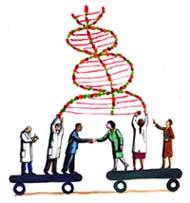Many questions have no right or wrong answer. They are a series of judgment calls for doctors, patients, investors, lab researchers, elected officials and regulators. For example, is health care a right or a privilege? That affects the discussion and the cost versus the value of technologies. Is value based on price or mortality rates? "We do not have an agreed-upon yardstick on how to determine value," notes Jeffery Kang, director of the Office of Clinical Standards and Quality at the Health Care Financing Administration, who spoke at a Wharton conference on New Ventures in Health Care.
The same situation afflicts venture capitalists, stock analysts and investors who must evaluate the financial risks, rewards and pricetags of untested drugs and unproven companies. As large pharmaceutical companies get larger with mergers and acquisitions they face the growing list of drugs that are facing patent expirations. More than half the top-selling pharmaceuticals will face competition from generic rivals within five years, according to John W. Holaday, CEO and founder of EntreMed, a pharmaceutical company in Rockville, Md.
Can drug companies develop new wonder drugs to sustain their stock prices? Or will the future of medicine belong to biotechnology and genetic treatments that can alter the course of diseases rather than treating symptoms? Holaday says the traditional lines separating these subgroups will blur in coming years as combination treatments emerge.
After decades of promising better, stronger and cheaper treatments, biotechnology’s promise has still not been attained, Holaday points out. But more results are gaining regulatory approval. Some 440 biotech products are in varying stages of clinical trials, and the number of partnerships and alliances has grown to more than $5 billion for each of the past two years, he adds.
"The bar has been rising for investors," Holaday says. "Only earnings-per-share is rewarded. Companies with a market capitalization of less than $200 million have depreciated as a group by 50%, while those with market caps of more than $1 billion have grown." And as the large get larger, small companies will have to make more rapid and critical decisions on whether and when to partner, joint venture, license technology or seek an independent route. "Two Davids can slay Goliath better than one," he adds. "That is the wave of the future. Companies must combine if their efforts are similar."
For companies seeking a future in health care, the role of technology has changed, says David P. Holveck, CEO of Centocor, a biotechnology firm in Malvern, Pa. There are several ways of treating the same condition, so companies must look for a range of treatments that include products they don’t manufacture.
"What you have to do now in product design is look at whether you can obsolete something already in the market; speed up turnaround times or keep the patient out of the hospital longer. Then you can look at the elasticity of pricing," he says. "Companies have to move away from a product strategy to a clinical franchise strategy–we have to market a standard of care with products that are out there, some of which we don’t sell."
"In the past five to 10 years, a greater understanding of genetic components and the molecular level of disease has emerged," says John Maraganore, general manager at Millennium BioTherapeutics, a subsidiary of Millennium Pharmaceuticals in Cambridge, Mass. "What was crudely defined as disease in the past was a description of symptoms. In 1994, there were only two antibody therapies. Today, we have 11 and those were developed through engineering." Thanks to those breakthroughs and developments, Maraganore points to uses of tamoxifen as a preventive treatment for certain cancers that will render previously life-threatening conditions as chronic — the way many people now view heart disease.
In two major instances to date, international pharmaceutical companies have teamed up to pursue competitive advantage in certain product lines. In the first, Pfizer, the New York City-based pharmaceutical giant, has agreed to work with Searle, the pharmaceutical subsidiary of Monsanto. Both organizations will jointly develop and market Celebrex, an arthritis drug, to counter an effort by Johnson & Johnson–Merck. Evaluating the financial and sales impact of those decisions isn’t easy, says Jonathan Northrup, director of the Internal Medicine Group at Eli Lilly, a pharmaceutical giant in Indianapolis, Ind. But the future of corporate cooperation will bring more such alliances from the laboratory to the executive suite.
"Partnering may shift from the innovation to the development stage," Northrup says. "Companies may come together not only to develop products for their own portfolios but also for other companies. When Pfizer and Warner-Lambert working together on Lipitor, the partnering multiple (for sales) was five times the estimates, compared with going solo."
Companies will have to decide how many partners, at which points in the research, development, manufacturing and sales life cycles plus identifying the specific resources needed, says Walter Moos, chairman and CEO of MitoKor, a biotech firm in San Diego, Calif. "In the new technology math 1+0= 0," he says. "Going it alone doesn’t work anymore."



